Aberrant Lizards


These are lizards with an unusual appearance that does not conform to the typical appearance of their species in color, pigmentation, pattern, or other physical characteristics. |
|||
Spiny Lizards - Sceloporus |
|||
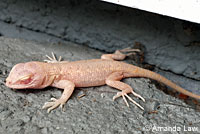 |
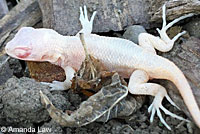 |
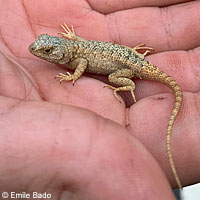 |
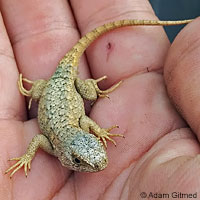 |
| Albino hatchling Coast Range Fence Lizard found in late September, Santa Clara County © Amanda Law |
Hypomelanistic juvenile Coast Range Fence Lizard, Marin County © Emile Bado |
Hypomelanistic juvenile Coast Range Fence Lizard, Marin County © Adam Gitmed |
|
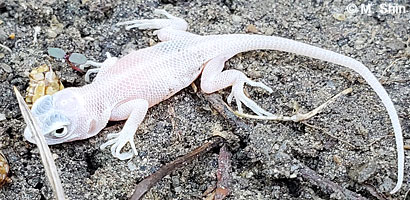 |
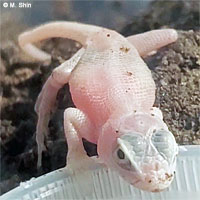 |
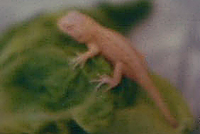 |
|
| This hatchling San Joaquin Fence Lizard without the typical pigments was found in a backyard in August in Bakersfield, Kern County,, but since it has dark eyes it's not an albino, it's leucistic. © M. Shin |
Tiny hatchling albino Coast Range Fence Lizard missing part of its tail, Alameda County. (From a 1976 Polaroid.) | ||
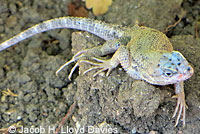 |
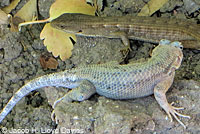 |
 |
|
| This unusually pale adult Great Basin Fence Lizard found in Orange County appears to be missing some of the typical dark pigment. (That's a San Diego Alligator Lizard behind it sharing its territory.) © Jacob H. Lloyd Davies | This is the same lizard shown to the left, photographed about 5 weeks later. It looks even paler now. The lack of color appears to be genetic on this individual, but it would be leucistic, not albino, since the eyes are dark. © Jacob H. Lloyd Davies | ||
 |
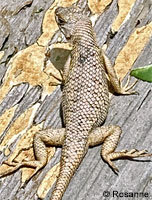 |
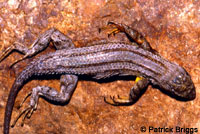 |
|
| This unusual pale yellow, possibly hypomelanistic, Great Basin Fence Lizard was photographed in a yard in San Diego County in early May. © Rosanne |
© Patrick Briggs Unusual striped Great Basin Fence Lizard from San Bernardino County, where a striped form occurs among populations of normally-patterned fence lizards. |
||
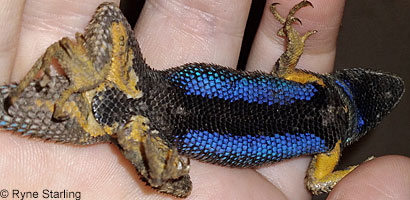 |
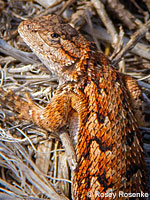 |
 |
|
| Most adult male Western Fence Lizards have pale coloring on the throat and venter around the patches of blue, but some are black like this male Coast Range Fence Lizards found in southern Napa County during the breeding season. His blue coloring is also very intense. © Ryne Starling | Adult female Coast Range Fence Lizard with unusually bright orange coloring, Marin County, © Rosey Rosenke. |
||
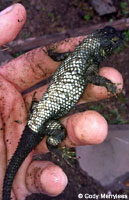 |
|||
| Adult Great Basin Fence Lizard, Riverside County with unusually bright white scales. © Cody Merylees | |||
Spiny Lizards with Rusty-Orange or Yellow or Other Unusual Coloring that Appears to be Added to the Skin |
|||
| I have been sent quite a few pictures of spiny lizards that appear to have an unnatural color painted on them, some of which you can see below. Most are rusty-orange or yellow, but some are white or gray or bluish. These are most likely not naturally-occurring aberrant pigments, though that is sometimes observed, as you can see above. These unnatural colors are most likely from human-made substances such as paint or rust or some other chemical. In one case the evidence of where someone painted the lizard was found. These colors could also be added to the lizard in a place where it takes shelter or overwinters. (Someone sent me pictures of a gray lizard that we figured out was colored by paint recently used on her house.) Most of these lizards are Great Basin Fence Lizards, probably because they are common lizards that live among humans in the most populated areas of the state and are easily observed. Living among humans makes them more likely to become contaminated by paint or chemicals or decorated by mischievous boys. If an artificial color has been added to the lizard's skin it should fade with time and disappear when the skin is shed. This was observed on a bright orange lizard that was regularly seen at public gardens in Pasadena. The same lizard was observed a few months later with the color faded considerably, showing that the color was added to the skin and not a natural pigment. Other lizards show signs of the skin peeling away the added color. However, some of these lizards were found in undeveloped open space where human-used chemical contamination is not as likely a cause. It has been suggested that these lizards might be covered with fungal spores or pollen. I received one report of orange-yellow fence lizards that were captured in California that were covered with something resembling spores or pollen that was easily brushed off, which confirms that theory. Unfortunately, I don't have pictures of them to confirm that. A similarly-colored orange American Alligator was seen in South Carolina. It was suggested that it might have overwintered in a rusty culvert pipe where the rust gave it the color, but again, that was just one theory. USA Today 2/10/17. |
|||
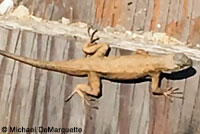 |
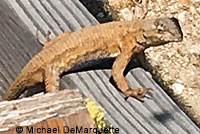 |
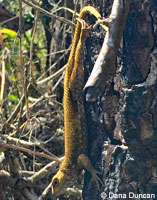 |
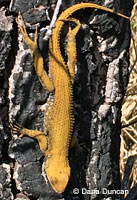 |
| This unusually-colored Great Basin Fence Lizard was found in May in the San Fernando Valley, Los Angeles County. © Michael DeMarquette. |
This is another apparent Great Basin Fence Lizard with a rusty-orange coloration that was found in late February in the Santa Monica Mountains of Los Angeles County. © Dana Duncan | ||
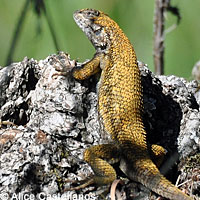 |
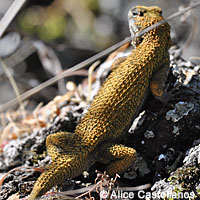 |
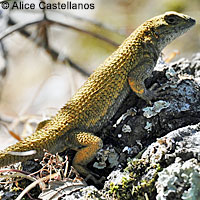 |
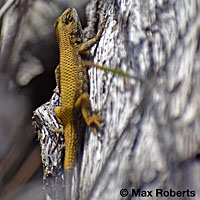 |
| This unusually-colored adult Coast Range Fence Lizard was photographed in February in Contra Costa County. © Alice Castellanos |
This is another Great Basin Fence Lizard from Los Angeles County with rusty coloring, photographed in mid February © Max Roberts |
||
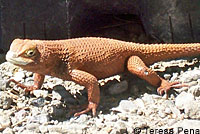 |
 |
 |
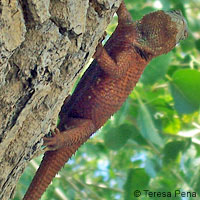 |
| This adult Yellow-backed Spiny Lizard with orange coloring was photographed on someone's property in Churchill County, Nevada in mid July. © Teresa Pena | |||
 |
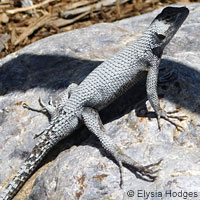 |
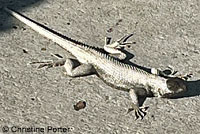 |
|
| This rusty-colored adult Great Basin Fence Lizard was found in the Santa Monica Mountains in Los Angeles County in late March. © James Hess | © Elysia Hodges This adult Great Basin Fence Lizard was found in Orange County. It's not orange or yellowish like the others, it has some sort of white substance on much of its body. You can see some skin shedding from the nose, and part of the head is the normal color where the skin that was painted white has been shed. In a picture taken a few days earlier the lizard's head was completely white. |
© Christine Porter This unnaturally white Great Basin Fence Lizard was found in Orange County in early March. |
|
 |
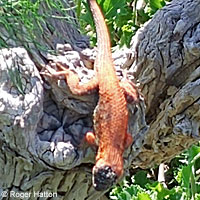 |
 |
|
| © Roger Hatton This bright orange Great Basin Fence Lizard was observed in Los Angeles County in late March in a public garden. The person who reported it knows and has handled fence lizards and describes the color as the color of the skin, not a color that was added. However, months later when the skin started shedding it became apparent that the color was added to the skin. The cause of the coloring is not known. |
© Roger Hatton Two weeks later the lizard shown to the left appears a bit duller in color and a little "dustier" looking when in the shade, which might indicate that it is indeed covered with some substance that gives it the orange color. We can also see that he is a male, and now during the breeding season he has been observed interacting with females who apparently don't mind his unusual appearance. I wonder if it helps make him look more attractive to them. A few months after receiving this picture the orange skin had slowly faded even more and half of it had shed off and his new skin coloring was normal. |
||
 |
 |
 |
|
| © Wendy This adult fence lizard was found in a yard in Los Angeles County. The picture in the middle shows a lizard with an orange head while the one on the left has a dark head which indicates that the lizard has started shedding its skin. As usual, the cause of the orange coloring was unknown when I was first asked about it. After I told her the color was added on in some way, her reptile enthusiast son searched the area to try to catch the lizard to find out what might have caused it. Instead, he found a paint mark on a neighbor's brick, shown in the picture on the right. The mystery is solved for this orange lizard - it was a victim of someone with a can of safety orange spray paint and a sick sense of humor. It makes me wonder how many of the other unusually-colored lizards were also the result of paint pranks. You can see in a photo below taken several days later that the lizard is still hanging out at the scene of the crime. |
|||
 |
 |
 |
|
| © Wendy |
This unusually silver-blue-colored Great Basin Fence Lizard was found in San Diego County. © Ralph Petrozello | ||
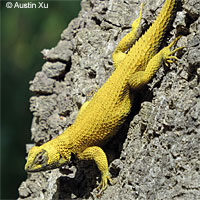 |
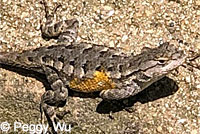 |
||
| Adult Great Basin Fence Lizard observed in mid March on a trail in Orange County. © Austin Xu A herpetologist suggested that this lizard might have been covered in fungal spores. It's not clear if he was talking about Yellow Fungus Disease (aka CANV) which sometimes afflicts captive lizards, but this lizard and the others in this section all appear to be in good health and living in clean habitats, which makes that disease an unlikely cause of the unusual coloring. Nevertheless it's an interesting theory for the color. You can read more comments about this lizard at its observation page on iNaturalist. |
© Peggy Wu You can read about this partially-yellow Great Basin Fence Lizard that was photographed at the L.A. Zoo in L.A. County on iNaturalist. It looks like some of the other lizards on this page, but only on a small part of its body. Maybe the rest of the body was yellow but when the lizard shed its skin the yellow patch of skin did not get removed. Or maybe only that part was colored. There's no way to know. |
||
| Naturally Golden-colored Eastern Fence Lizard | |||
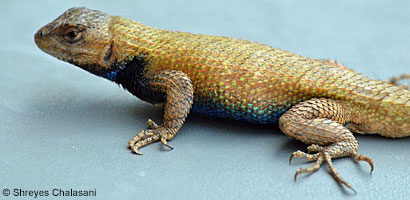 |
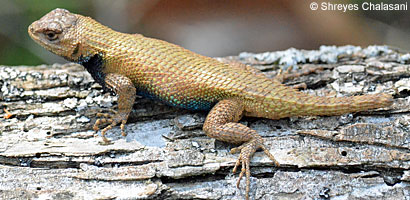 |
||
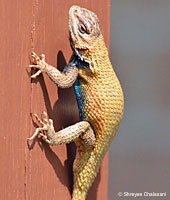 |
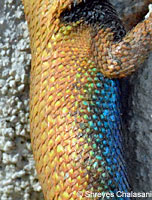 |
||
| All four photos shown above © Shreyes Chalasani | |||
| This adult male Eastern Fence Lizard was found in North Carolina as a hatchling with no pattern and a yellowish gray coloring that became the vibrant golden color you seen in the photos shown above. This lizard has been observed for two years which indicates that its coloring is natural and not added on. The photographer, Shreyes Chalasani, also reports that he found and was able to handle yellow/orange Western Fence Lizards in California similar to those shown above that were colored by spores or pollen that he could easily brushed off. This confirms that the spores/pollen theory is accurate, at least for the lizards he found. It may not apply to all of the lizards shown above. |
|||
Alligator Lizards - Elgaria |
|||
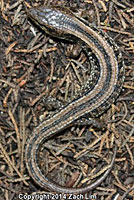 |
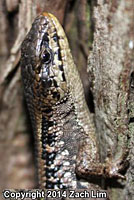 |
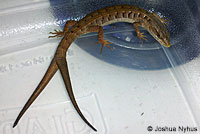 |
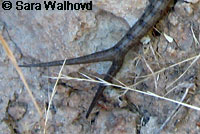 |
| Adult San Francisco Alligator Lizard with an atypical well-defined dark stripe on the back, San Mateo County © Zach Lim | Adult Southern Alligator Lizard, Los Angeles County with a large forked tail. © Joshua Nyhus | Adult Southern Alligator Lizard, Placer County, with a forked regenerated tail. © Sara Walhovd |
|
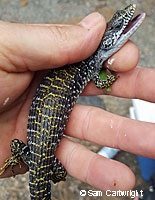 |
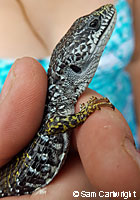 |
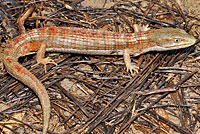 |
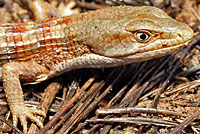 |
| An interestingly-colored adult Shasta Alligator Lizard, Colusa County. © Sam Cartwright |
Adult Southern Alligator Lizard with no black on the back and lots of orange coloring, Santa Clara County | ||
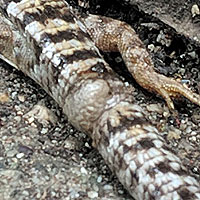 |
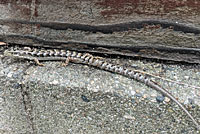 |
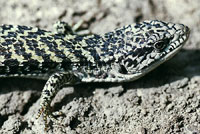 |
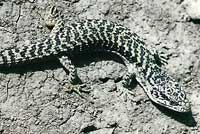 |
| Adult Southern Alligator Lizard. This lizard apparently suffered an injury to its tail (which was partly regenerated already), but the tail did not break off at the point of injury. The injury healed irregularly as you can see here. | Adult San Francisco Alligator Lizard with no brown coloring. | ||
 |
 |
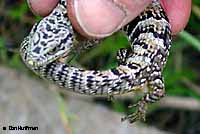 |
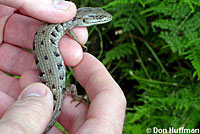 |
| Melanistic adult male Southern Alligator Lizard, coastal Los Angeles County. © Jean Taves | Young adult Southern Alligator Lizard with high-contrast pattern, coastal Los Angeles County © Don Huffman |
Young adult Southern Alligator Lizard with few markings, coastal Los Angeles County © Don Huffman |
|
 |
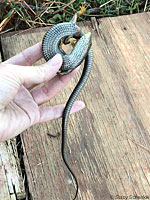 |
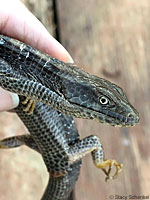 |
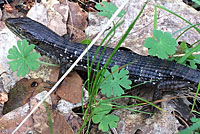 |
| This melanistic adult Southern Alligator Lizard from Orange County has a lot of black pigment, but does not completely lack other pigments since the feet are still yellow. © Stacy Schenkel |
Very dark adult Southern Alligator Lizard from Sacramento County |
||
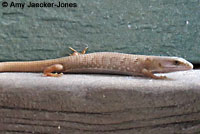 |
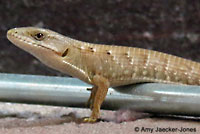 |
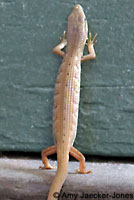 |
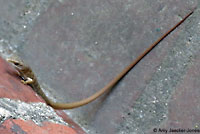 |
| An amelanistic (without black pigment) Southern Alligator Lizard observed in Los Angeles County with a very long tail. © Amy Jaecker-Jones | |||
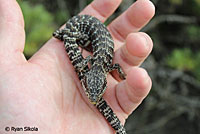 |
 |
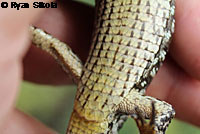 |
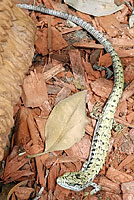 |
| This unusually-colored Southern Alligator Lizard found on a San Luis Obispo County beach is probably anerythristic, or lacking any red pigment. © Ryan Sikola | This adult Southern Alligator Lizard was found in a backyard in Huntington Beach in Orange County. It appears to be Anerythristic - missing the red or orange pigment that would give it the red or brown coloring typical of the species. | ||
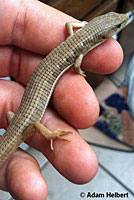 |
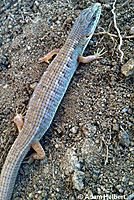 |
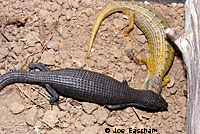 |
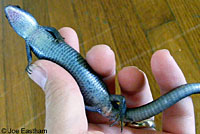 |
| An almost patternless amelanistic without black pigment) adult Southern Alligator Lizard from Riverside County © Adam Helbert |
Dark (melanistic) adult Shasta Alligator Lizard with normal-colored adult above, Humboldt County. © Joe Eastham |
Underside of melanistic adult Shasta Alligator Lizard seen to the left, Humboldt County. © Joe Eastham | |
 |
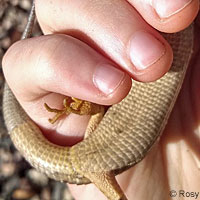 |
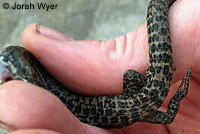 |
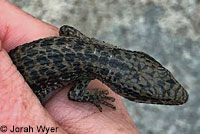 |
| This adult Southern Alligator Lizard found in Ventura appears to be amelanistic (without black pigment) © Rosy | This very dark sub-adult Sierra Alligator Lizard was found at about 8,100 ft. elevation in the Sierra Nevada mountains in El Dorado County. © Jorah Wyer | ||
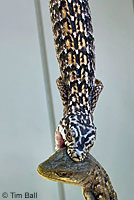 |
 |
 |
|
| The male (top) of this courting pair has an unusually bright pattern. © Tim Ball | Very dark adult Southern Alligator Lizard with regrown tail, Marin County © Anonymous | ||
 |
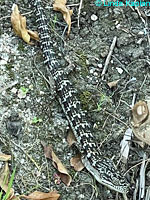 |
||
| This foot-long Orange County adult Southern Alligator Lizard with an unbroken tail appears to be anerythristic, lacking the red pigment that produces the brown and reddish coloring normally found on this species. © Linda Kaplan |
|||
 |
|||
| Monterey County adult Southern Alligator Lizard that appears to be anerythristic © Patrick Frost | |||
Patternless Alligator Lizards |
|||
 |
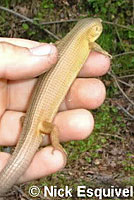 |
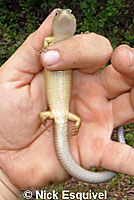 |
 |
| Patternless adult (probably amelanistic) San Francisco Alligator Lizard Santa Clara County. © Nick Esquivel |
A patternless adult San Francisco Alligator Lizard from Santa Cruz County. © Scott Peden | ||
 |
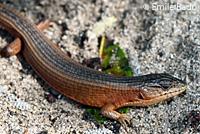 |
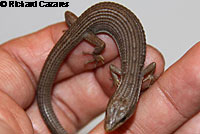 |
|
| The red and patternless San Francisco Alligator Lizard was found in Santa Cruz County. © Emile Bado | A juvenile Southern Alligator Lizard with very little pattern from San Diego County. © Richard Cazares |
||
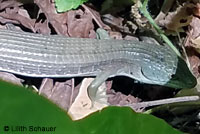 |
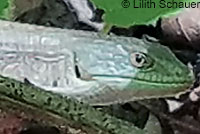 |
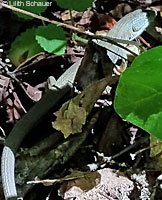 |
|
| This nearly patternless and colorless adult Southern Alligator Lizard was photographed in Sonoma County. The eyes are the normal color, which rules out albinism, so this might be a leucistic lizard. © Lilith Schauer | |||
Side-blotched Lizards - Uta |
|||
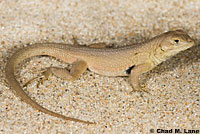 |
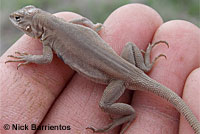 |
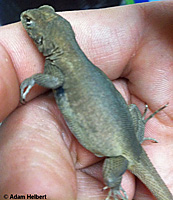 |
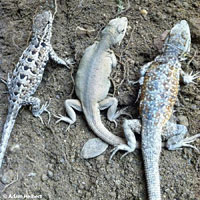 |
| Patternless adult Western Side-blotched Lizard, San Joaquin County. © Chad M. Lane |
Patternless adult Western Side-blotched Lizard, Riverside County © Nick Barrientos |
Patternless adult female Western Side-blotched Lizard, Riverside County © Adam Helbert |
Riverside County patternless gravid adult female Western Side-blotched Lizard in center with a normally-patterned adult female on the left and a normally-patterned adult male on the right. © Adam Helbert |
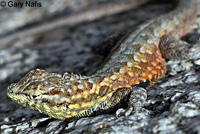 |
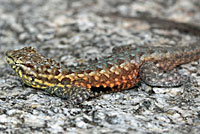 |
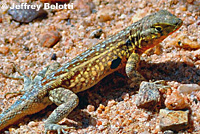 |
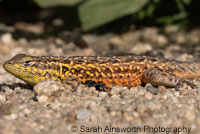 |
| Adult male with bright orange on sides, San Diego County | Adult male with bright yellow on the sides, San Diego County. © Jeffrey Belotti |
This bright orange and yellow adult male was photographed in early April on the Palos Verdes Peninsula, Los Angeles County. © Sarah Ainsworth Photography | |
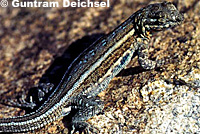 |
 |
||
| Western Side-blotched Lizards are occasionally found with well-defined stripes like we see on this adult female from San Bernardino County © Guntram Deichsel |
Striped gravid female Western Side-blotched Lizard, Riverside County © Jim Brock |
||
| Whiptails - Aspidoscelis | |||
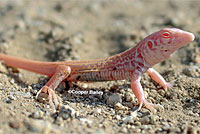 |
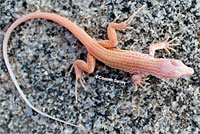 |
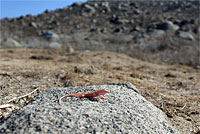 |
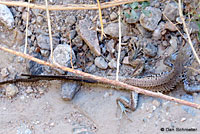 |
| Albino juvenile Coastal Whiptail, Riverside County © Cooper Bailey | This Great Basin Whiptail from Riverside County has an abnormal forked tail, probably resulting from an injury. © Dan Schroeter | ||
Miscellaneous Aberrant Lizards |
|||
 |
 |
 |
 |
| Southern Desert Horned Lizards don't usually have a striped pattern, but this Kern County adult does. © Todd Battey |
Spotted adult Desert Banded Gecko - with no bands, Imperial County. © Stuart Young |
Unusually pale adult female Desert Night Lizard, Mono County © Adam G. Clause |
Unusually pale adult female Desert Night Lizard with orange highlights, Mono County © Adam G. Clause |
 |
|||
| Hypomelanistic adult Common Chuckwalla, Riverside County © Brody Trent |
|||
Return to the Top
© 2000 -
